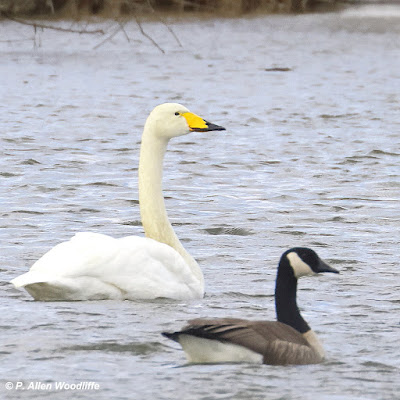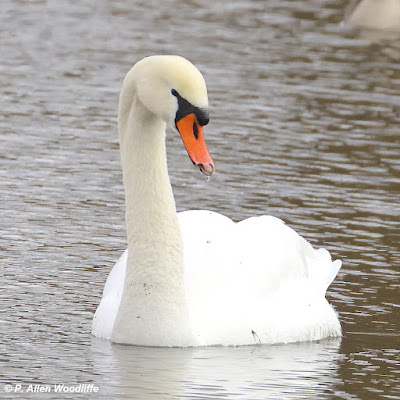The Barred Owl that has been at Shrewsbury since late December or earlier, continues to hang around. It does move around the village regularly, but always seems to find a roost to spend the day time hours. This, of course, makes it a real challenge for birders looking for it and basing their search on where it was seen the day before. Especially frustrating if one comes from a distance, and keeps striking out, which has happened in at least a few cases.
I was out a few days ago, and with quite up-to-date information on where to find it, was successful. I was able to approach it carefully and quietly with a long telephoto lens. While the owl saw me it did not seem to be all that concerned.
In the few minutes I was there, it spent most of its time with its eyes closed, apparently unconcerned and even ignoring me. That was fine with me, I was not offended in the least :-).
With the above normal temperatures lately, even shorebirds are starting to appear. There have been up to 3 Killdeer seen regularly along the Erieau Marsh/Rail Trail. It is possible that they never left, but if so, where were they over the last couple of months as they were not reported at any of the usual birding spots by birders out and about in various places. At any rate they seem to be predictable at this location. This first one was one of three seen on Feb 8.
I was out again today (Feb 16) and saw at least three.
Interestingly another shorebird, a Lesser Yellowlegs, was photographed in a slightly flooded field in the area, beside McGeachy Pond, just yesterday. Given the warm temperatures, up to about 15C, one might expect birds to be confused and tempted to get moving. I checked the area today, but as is often the case, the bit of water in the field yesterday, was pretty much gone today. There were other ponded areas, but I did not come across the bird. Perhaps it got a little concerned in the past 24 hours as the temperature had changed considerably, as did the wind direction, and it might have headed back a little farther south. I had one at the foot of Rondeau Bay back on Feb 27, 2017, but this one certainly has eclipsed that previously earliest date.
Regular readers will notice my mention of lots of Bald Eagles as of late. That continues, with numerous sub-adult birds frequenting the area. They are always fun to photograph. I haven't got tired of them yet when they cooperate.
The adults are paired up, and hanging out in their territory. This pair was in the Shrewsbury area, and there are two nests within 2-3 kilometres of where this pair was seen, so it is likely from one of those territories unless there is another territory I have yet to discover.
While it takes 5 years for a Bald Eagle to attain fully adult plumage, with both a white head and tail, sometimes slightly younger birds will mate if there is territory available. I came across this sub-adult checking out the nest seen from along the west South Point Trail at Rondeau a few days ago. Unless one of the adults that occupied this territory in previous years has met its demise, I expect this particular bird was just checking out the nest, maybe getting some ideas of what it had to put together in a future year.

A new nesting pair has shown up in the Keith McLean Conservation Lands area. Perhaps it is the pair that showed interest last year in the nesting platform that is quite visible along the trail at that conservation area, but maybe felt a little too exposed with the many birders and hikers exploring the area? At any rate, this nest is considerably more secluded. In fact I estimated I was at least 800 metres from the nest when I got this highly cropped fuzzy foto, and that was from about as close as the official trail goes. In scanning around, it was the white head that first got my attention, otherwise I probably would have missed it.

I have checked some of the other nests that I know about in southern Chatham-Kent, and often see an adult perched on the side of the nest or on a branch very close by. Late February is very typical of the beginning of nest occupancy, so if you get a chance to see a nest, take a closer look to see if there is the white head of an adult in a position that indicates it is incubating one or more eggs.
Certainly not an indicator of spring, but while checking out the Clear Creek Forest Prov Park area a few days ago, I saw this Rough-legged Hawk soaring over the grassy field. It is normally a wintering species, although they have been very few and far between this winter. Some will linger, or be late spring migrants, as on one occasion several years ago, I and another birder had one at Rondeau in very early June!
While there was still ice on Rondeau Bay, a swan of some type was caught in the ice, or died and remained there. A young Northern Harrier, found it worthwhile to dine on.
A few days later I saw this young Northern Harrier, possibly even the same bird as it was only about a kilometre away from the previous spot, perched at the top of this evergreen shrub at the KMCL.
The water treatment outlet on the Thames River in Chatham was not a productive spot to see much diversity of waterfowl this year, unless one is content with Canada Geese, Mallards and American Black Ducks. The only other species of waterfowl I saw this winter, so far, was a single Green-winged Teal. But I partially satisfied my photographic urges when there, focusing on the Mallards and Am Black Ducks. The latter species used to be the more abundant of the two species here in the east, if you go back far enough to before settlement opened up the landscape. Here is a pair of MALL, with the female in the foreground and a male in the background.
Next is a pair of ABDU, with the male in the foreground.
And here is a comparison of a male ABDU in the foreground and a female MALL in the background.

Unless there is a major return to winter over the next few weeks, I don't expect this water treatment outlet to be a place to see much until next winter!
If you would like to subscribe, or unsubscribe, to Nature Nuggets, send an email to: prairietramper@gmail.com
























































